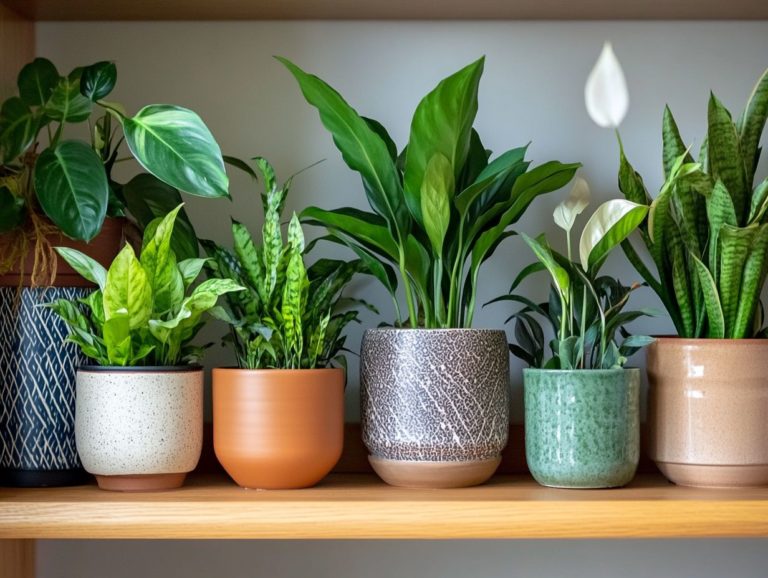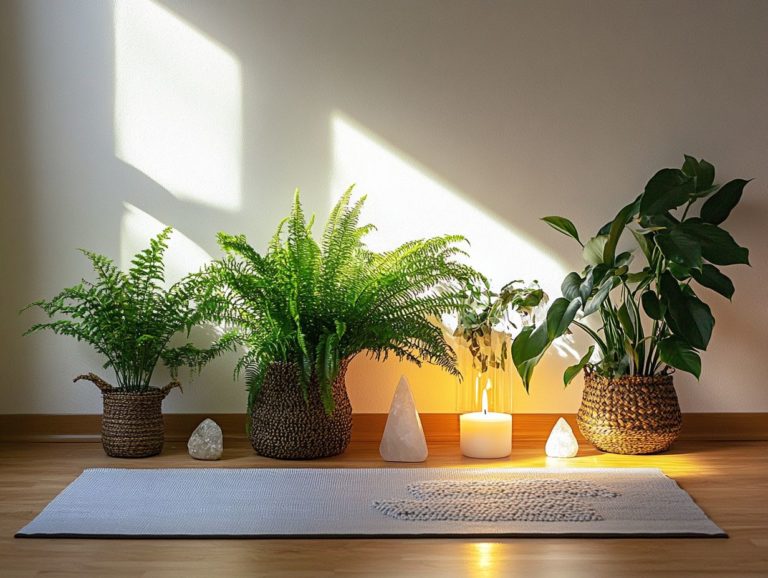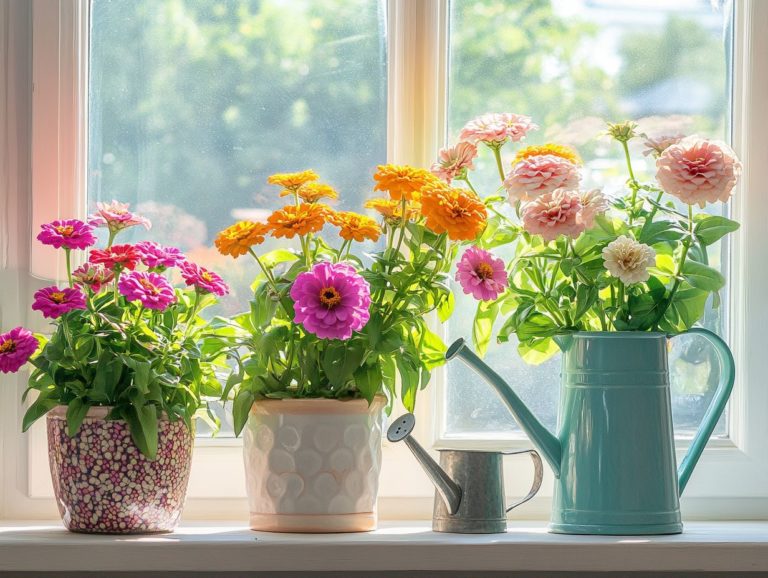How to Grow Indoor Fuchsias Successfully
Indoor fuchsias are exquisite plants. Their beautiful blooms can elevate the ambiance of any indoor setting with vibrant colors.
Successfully growing these beauties requires a discerning eye for the right fuchsia varieties and an understanding of their essential conditions.
This guide will explore the nuances of light, temperature, and humidity, which are critical for growing fuchsias, while also addressing the management of common pests and diseases to help your indoor fuchsias flourish.
Get ready to unleash your inner gardener and watch your home come alive with these stunning plants!
Contents
- Key Takeaways:
- Choosing the Right Fuchsia Varieties
- Essential Growing Conditions for Indoor Fuchsias
- Planting and Caring for Indoor Fuchsias
- Common Pests and Diseases of Indoor Fuchsias
- Tips for Maintaining Healthy Indoor Fuchsias
- Frequently Asked Questions
- Discover the Best Conditions for Thriving Indoor Fuchsias!
- What Type of Soil Should I Use for My Indoor Fuchsias?
- How Often Should I Water My Indoor Fuchsias?
- Do I Need to Fertilize My Indoor Fuchsias?
- Can I Prune My Indoor Fuchsias to Encourage More Blooms?
- How Can I Propagate My Indoor Fuchsias Successfully?
Key Takeaways:
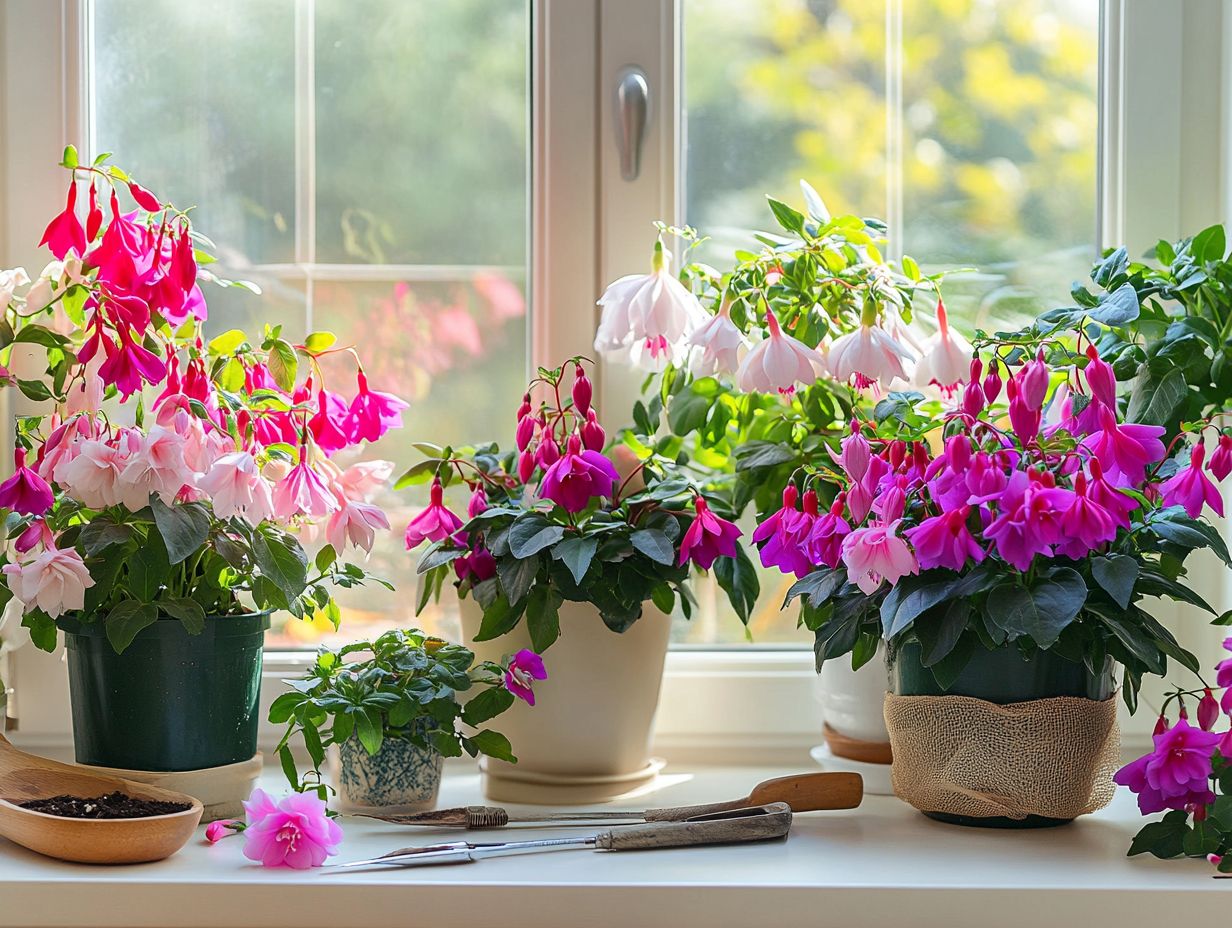
- Select fuchsia varieties that fit your available space and enjoy the sunlight they crave!
- Provide the essential growing conditions, including proper light, temperature, and humidity for thriving indoor fuchsias.
- Maintain healthy indoor fuchsias by regularly pruning, fertilizing, repotting, and promptly addressing common pests and diseases.
What are Indoor Fuchsias?
Indoor fuchsias, particularly the Fuchsia spp., are captivating flowering plants from Central and South America. They re beloved for their exquisite blooms, which infuse vibrant colors into indoor spaces.
With their tender varieties, these plants thrive in controlled environments, making them perfect for adding a touch of elegance to homes while attracting charming pollinators like hummingbirds.
With cascading growth habits, indoor fuchsias can transform any area into a lush sanctuary. They aren t just a feast for the eyes; these plants have remarkable traits, such as vibrant, pendulous flowers that can bloom year-round when conditions are ideal.
Their moderate size allows them to fit seamlessly into smaller spaces, making them ideal for window sills or hanging baskets. Fuchsias prefer bright, indirect light and consistent moisture, essential for their health and flower production.
When you provide the right care, these enchanting plants not only elevate your indoor aesthetics but also become focal points that attract delightful hummingbirds, creating a lively indoor ecosystem.
Choosing the Right Fuchsia Varieties
When selecting fuchsia varieties for your indoor garden, consider several factors, including the weather conditions, the space available, and the specific light needs of different fuchsia types, whether tender or hardy species.
Factors to Consider
Several critical factors come into play when choosing fuchsia varieties, including light conditions, temperature control, and humidity levels. These elements significantly impact the plant’s overall health and growth, especially during seasonal changes.
Soil drainage is crucial; fuchsias thrive in well-draining soil, as excess moisture can lead to root rot. A mix that retains some moisture without becoming soggy is ideal for your plants.
Sunlight requirements also vary among fuchsia species; some prefer dappled shade, while others tolerate full sun. Understanding each variety’s specific needs is essential.
Temperature fluctuations are another key factor, as these tender varieties generally favor cooler temperatures. By attending to these elements, you ensure your fuchsia selections not only survive but truly flourish, offering vibrant blooms and lush greenery throughout the growing season.
Essential Growing Conditions for Indoor Fuchsias
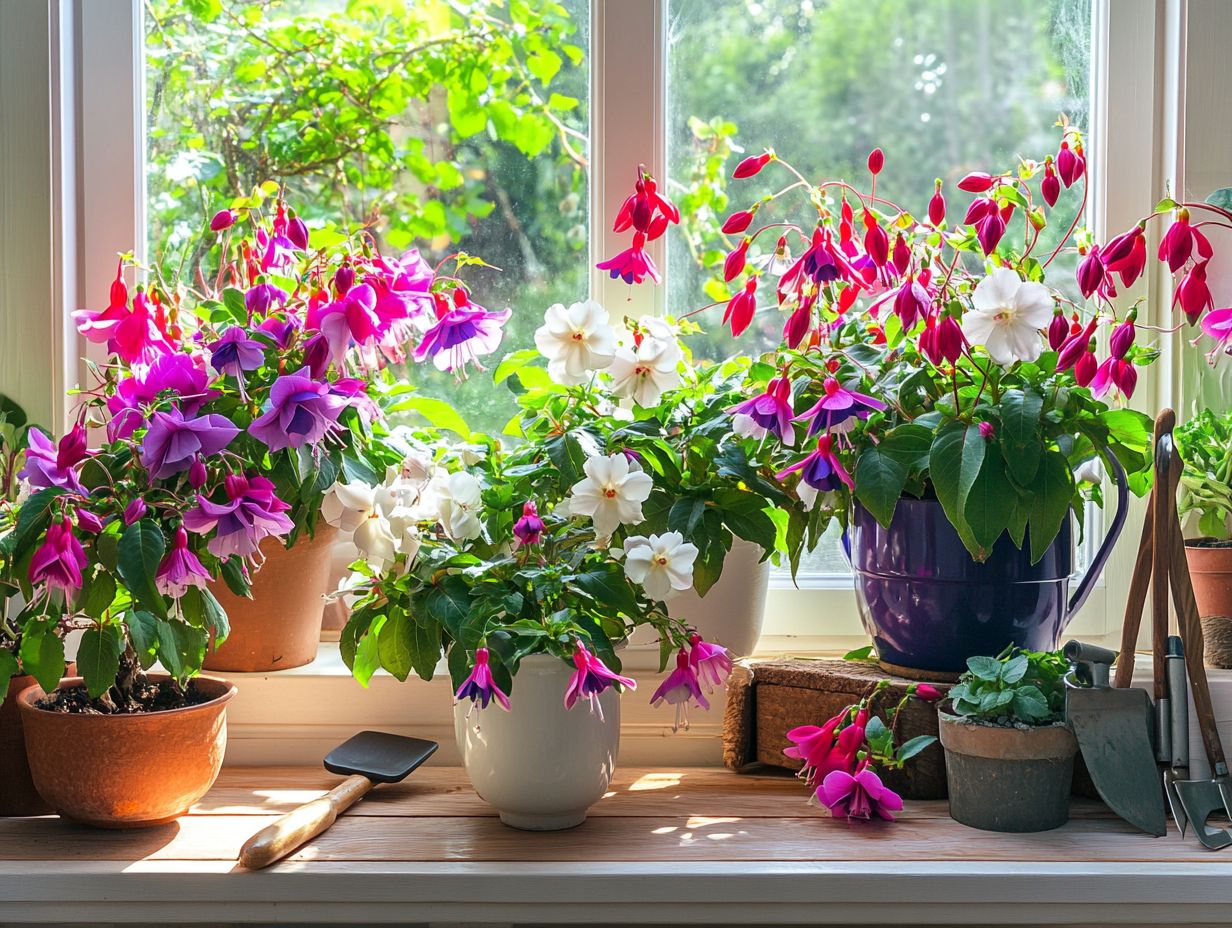
To successfully cultivate indoor fuchsias, grasp their essential growing conditions. This includes providing the specific light, temperature, and humidity levels that closely resemble their natural habitat, ultimately promoting vibrant flower production.
Light, Temperature, and Humidity Requirements
Fuchsias thrive in bright, indirect light and prefer cooler temperatures. The right humidity levels are crucial for enhancing their blooming potential and overall vitality.
To help your lovely plants flourish, position them near east or west-facing windows. This allows them to bask in gentle sunlight without being scorched by direct rays. Temperature management is vital; aim for a cozy range between 60 F and 70 F to avoid extreme heat fluctuations that could lead to wilting.
Humidity is also important; keep it between 40% and 60%. You can achieve this by misting your plants regularly or placing a humidifier nearby.
When it comes to watering, establish a consistent schedule that allows the soil to dry out slightly between waterings. This practice promotes strong root development, resulting in vibrant, healthy blooms. For those interested in expanding their gardening repertoire, learning how to grow indoor strawberries successfully can be a rewarding addition. By integrating these elements, you ensure that your fuchsias not only survive but truly thrive, showcasing their stunning flowers throughout the growing season.
Planting and Caring for Indoor Fuchsias
To cultivate thriving indoor fuchsias, adhere to meticulous planting and care practices. This includes choosing the right potting soil and adapting your care routine to the seasonal changes that influence their growth.
Steps for Successful Growth
The successful growth of your indoor fuchsias depends on a consistent watering schedule, timely repotting, and attentive care. These elements nurture their development and flower production.
To cultivate a lush, vibrant plant, grasp their specific light and temperature needs. Ensure they bask in bright, indirect sunlight. Establishing a watering routine that keeps the soil evenly moist without causing waterlogging is crucial; this prevents root rot and encourages stunning blooms.
Regularly check your plant for signs of distress like yellowing leaves or stunted growth. This will help you know when it’s time to repot, especially if root crowding becomes an issue. A combination of the right environmental conditions and diligent care practices lays the foundation for successful fuchsia cultivation.
Common Pests and Diseases of Indoor Fuchsias
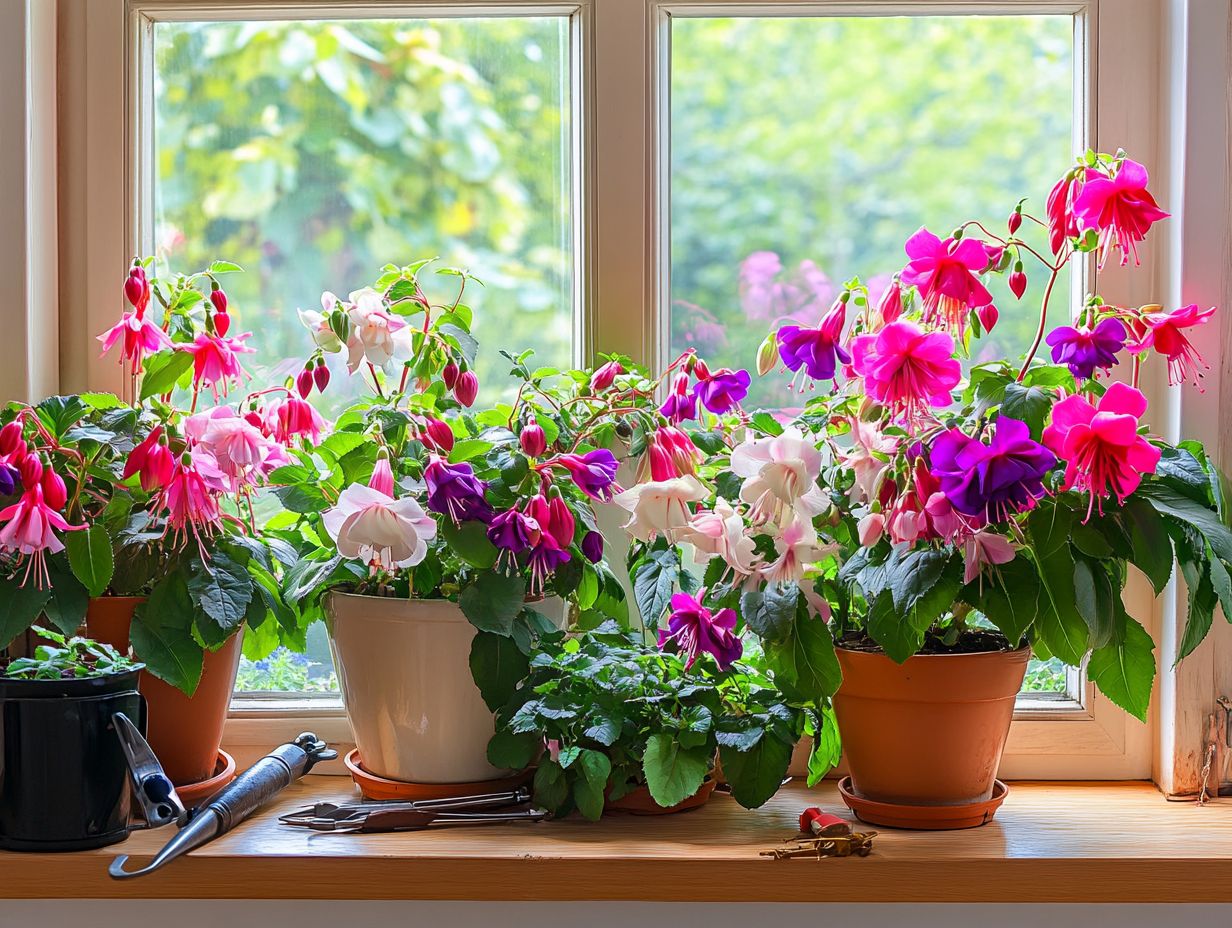
Indoor fuchsias can face various pests and diseases. Implementing effective pest management and disease control is essential to safeguard their health and prevent issues like leaf drop and root rot.
To effectively manage the vitality of these vibrant plants, familiarize yourself with the signs of specific pests like aphids, spider mites, and whiteflies. Symptoms such as wilting, leaf discoloration, or a sticky residue may indicate their presence. Recognize key diseases, including powdery mildew and root rot; symptoms may include fungal spores on leaves or a noticeable decline in plant vigor.
With this knowledge, you can implement targeted treatments, like using insecticidal soaps or neem oil for pests, along with proper watering practices to avoid over-saturation. Regular monitoring and preventive measures, such as good air circulation and appropriate light exposure, will further protect your fuchsias.
Tips for Maintaining Healthy Indoor Fuchsias
- Embrace effective pruning strategies.
- Follow targeted fertilization tips.
- Remember that these vibrant plants are heavy feeders, needing regular nutrients to thrive.
Start caring for your fuchsias today and share your growing experiences with fellow plant enthusiasts!
Pruning, Fertilizing, and Repotting
Pruning and fertilizing your indoor fuchsias are essential practices that elevate their growth and flowering. Timely repotting is also crucial, especially during seasonal shifts that influence their care.
By regularly trimming back those overgrown stems and dead flowers, you can encourage bushier growth. This helps produce vibrant blooms that will catch anyone s eye. Fertilize during the growing season, which spans from spring to summer, for the best results. This ensures your plants receive the necessary nutrients for optimal health.
For repotting, early spring is your prime time just before the plant starts growing more quickly. This gives the roots space to grow and helps them absorb essential nutrients. Remember, as seasons change, like the transition to shorter daylight hours in autumn, your indoor fuchsias may slow down growth. During this time, careful monitoring of water and nutrient intake becomes vital for keeping them thriving. If you’re also interested in indoor plants, consider learning how to grow indoor lavender successfully.
Frequently Asked Questions
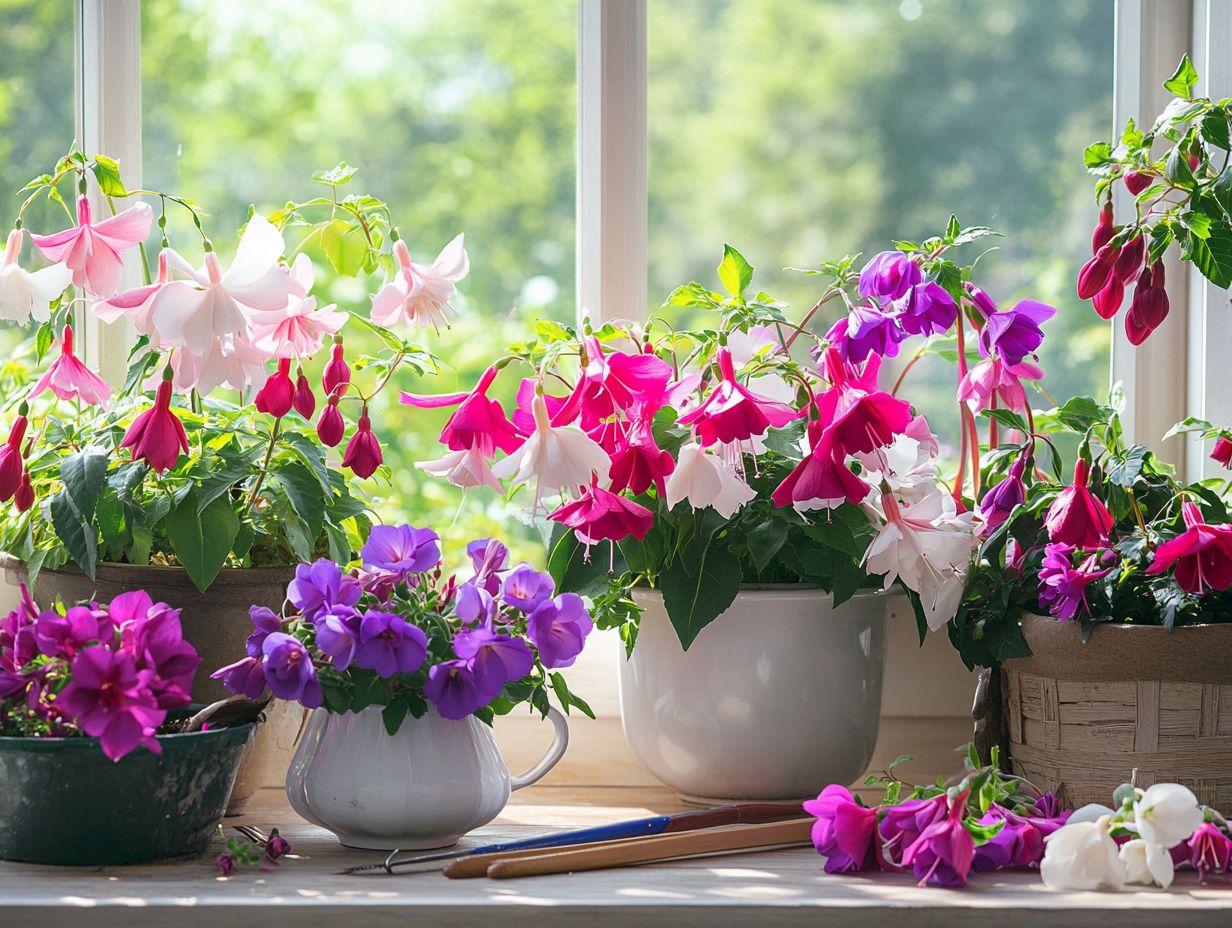
Discover the Best Conditions for Thriving Indoor Fuchsias!
Indoor fuchsias thrive in bright, indirect light and a cool environment with temperatures between 60-70 degrees Fahrenheit. These conditions make them ideal indoor plants for vibrant colors and stunning blooms.
What Type of Soil Should I Use for My Indoor Fuchsias?
Indoor fuchsias prefer well-draining, slightly acidic soil with a pH level of 6.0-6.5. A mix of potting soil, peat moss, and perlite will create optimal growing conditions and ensure good soil drainage for healthy roots.
How Often Should I Water My Indoor Fuchsias?
Fuchsias require regular watering, but avoid overwatering to prevent root rot. Water when the top inch of soil feels dry, usually every 2-3 days, and adapt your schedule according to humidity levels.
Do I Need to Fertilize My Indoor Fuchsias?
Yes, fertilize your fuchsias once a month during the growing season with a balanced fertilizer, as they are heavy feeders. Be sure to dilute the fertilizer to half strength before applying for the best results.
Can I Prune My Indoor Fuchsias to Encourage More Blooms?
Absolutely! Pruning is necessary for maintaining a compact and bushy shape in indoor fuchsias, which encourages more flower production. Prune in late winter or early spring before new growth appears, removing any dead or damaged branches.
How Can I Propagate My Indoor Fuchsias Successfully?
You can propagate indoor fuchsias by taking stem cuttings in spring or summer and rooting them in a moist potting mix. Keep the cuttings in a warm and humid environment until roots develop, then transplant them into individual pots.



